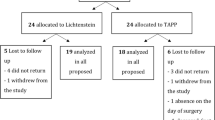Abstract
Background
The endoscopic totally extraperitoneal (TEP) mesh repair is nowadays a well-established tension-free method for inguinal hernia repair. Mainly based on animal studies and case reports, a concern about the risk of postoperative infertility was expressed. This clinical study aimed to evaluate the risk of infertility due to obstructive azoospermia in men of fertile age who underwent a bilateral hernia repair.
Methods
Over 3 years (2005–2008) 59 male patients, 18–60 years of age, underwent a bilateral TEP repair. Twenty-one of them were prospectively (“light mesh”) and 38 retrospectively (“heavy mesh”) evaluated for testicular volume and perfusion, serum levels of sexual hormones, ejaculate volume, and number of spermatic cells. Those parameters were determined preoperatively (prospective group) and not earlier than 3 months postoperatively (both groups).
Results
No significant difference between pre- and postoperative values was detected in the prospectively studied group. All postoperative parameters were within the normal range in the retrospective group. There was no evidence of impaired fertility in any patient due to the operation.
Conclusion
The standardized TEP technique for simultaneous bilateral inguinal hernia repair in male patients was not associated with a higher risk for postoperative infertility after mesh implantation. The use of heavy-weight meshes had no negative effect on fertility.




Similar content being viewed by others
References
Simons MP, Aufenacker T, Bay-Nielsen M et al (2009) European Hernia Society guidelines on the treatment of inguinal hernia in adult patients. Hernia 13:343–403
Kuhry E, van Veen RN, Langeveld HR et al (2007) Open or endoscopic total extraperitoneal inguinal hernia repair? A systematic review. Surg Endosc 21:161–166
Tamme C, Scheidbach H, Hampe C et al (2003) Totally extraperitoneal endoscopic inguinal hernia repair (TEP). Surg Endosc 17:190–195
Weyhe D, Meurer K, Belyaev O et al (2007) Do various mesh placement techniques affect the outcome in totally extraperitoneal hernia repair? What is the role of the surgeon? J Laparoendosc Adv Surg Tech 17:749–757
Pawanindra LAL, Philips P, Chander J et al (2010) Is unilateral laparoscopic TEP inguinal hernia repair a job half done? The case for bilateral repair. Surg Endosc 24:1737–1745
Weyhe D, Belyaev O, Müller C et al (2007) Improving outcomes in hernia repair by the use of light meshes—a comparison of different implant constructions based on a critical appraisal of the literature. World J Surg 31:234–244
Shin D, Lipshultz LI, Goldstein M et al (2005) Herniorrhaphy with polypropylene mesh causing inguinal vasal obstruction. A preventable cause of obstructive azoospermia. Ann Surg 241:553–558
Peiper C, Junge K, Klinge W et al (2006) Is there a risk of infertility after inguinal mesh repair? Experimental studies in the pig and the rabbit. Hernia 10:7–12
Maciel LC, Glina S, Palma PC et al (2007) Histopathological alterations of the vas deferens in rats exposed to polypropylene mesh. BJU Int 100:187–190
Yamaguchi K, Ishikawa T, Nakano Y et al (2008) Rapidly progressing, late-onset obstructive azoospermia linked to herniorrhaphy with mesh. Fertil Steril 90:5–7
Agarwal BB, Sinha BK, Mahajan KC (2008) The risk of communicating TEP-related infertility risk is an opportunity and not a “Cinderella concern” any more. Surg Endosc 22:1557–1558
Fitzgibbons RJ (2005) Can we be sure polypropylene mesh causes infertility? Ann Surg 241:559–561
Peiper C, Junge K, Klinge U et al (2005) The influence of inguinal mesh repair on the spermatic cord: a pilot study in the rabbit. J Investig Surg 18:273–278
Uzzo RG, Lemack GE, Morrissey KP et al (1999) The effects of mesh bioprosthesis on the spermatic cord structures: a preliminary report in a canine model. J Urol 161:1344–1349
Goldenberg A, Paula JF (2005) Effects of the polypropylene mesh implanted through inguinotomy in the spermatic funiculus, epididium and testis of dogs. Acta Cir Bras 20:461–467
Junge K, Binnebösel M, Rosch R et al (2008) Influence of mesh materials on the integrity of the vas deferens following Lichtenstein hernioplasty: an experimental model. Hernia 12:621–626
Junge K, Binnebösel M, Kauffmann C et al (2011) Damage to the spermatic cord by the Lichtenstein and TAPP procedures in a pig model. Surg Endosc 25(1):146–152
Berndsen FH, Bjursten LM, Simanaitis M et al (2004) Does mesh implantation affect the spermatic cord structures after inguinal hernia surgery? Eur Surg Res 36:318–322
Abasiyanik A, Güvenc H, Yavuzer D et al (1997) The effect of iatrogenic vas deferens injury on fertility in an experimental rat model. J Pediatr Surg 32:1144–1146
Hallén M, Sandblom G, Nordin P et al (2011) Male infertility after mesh hernia repair: a prospective study. Surgery 149(2):179–184
Röhrig B, Prel J, Wachtlin D et al (2010) Sample size calculation in clinical trials: part 13 of a series on evaluation of scientific publications. Dtsch Arztebl Int 107:552–556
Horstmann R, Hellwig M, Classen C et al (2006) Impact of polypropylene amount on functional outcome and quality of life after inguinal hernia repair by the TAPP procedure using pure, mixed, and titanium-coated meshes. World J Surg 30:1742–1749
Peeters E, Spiessens C, Oyen R et al (2010) Laparoscopic inguinal hernia repair in men with lightweight meshes may significantly impair sperm motility. Ann Surg 252:240–246
Dilek ON, Yucel A, Akbulut G et al (2005) Are there adverse effects of herniorrhaphy techniques on testicular perfusion? Evaluation by color Doppler ultrasonography. Urol Int 75:167–169
Akbulut G, Serteser M, Yücel A et al (2003) Can laparoscopic hernia repair alter function and volume of testis? Randomized clinical trial. Surg Laparosc Endosc Percutaneous Tech 13:377–381
Valenti G, Baldassarre E (2006) Vasal obstruction after hernioplasty. The importance of surgical strategy in preventing azoospermia. Ann Surg 244:160
Conflict of interest
The authors have no conflicts of interest to declare.
Author information
Authors and Affiliations
Corresponding author
Additional information
S. Skawran and D. Weyhe have contributed equally to this work.
Rights and permissions
About this article
Cite this article
Skawran, S., Weyhe, D., Schmitz, B. et al. Bilateral Endoscopic Total Extraperitoneal (TEP) Inguinal Hernia Repair Does Not Induce Obstructive Azoospermia: Data of a Retrospective and Prospective Trial. World J Surg 35, 1643–1648 (2011). https://doi.org/10.1007/s00268-011-1072-0
Published:
Issue Date:
DOI: https://doi.org/10.1007/s00268-011-1072-0



